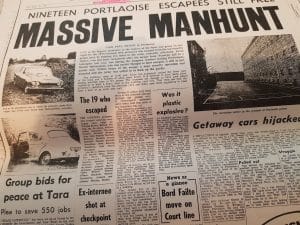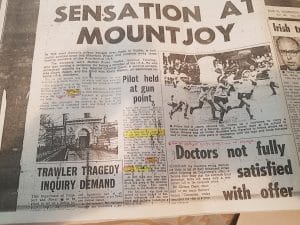‘A founder of the East Tyrone Brigade, Hughes was the key planner of the two most successful prison escapes staged by the IRA of the 1970s’
‘The springing of three IRA men from the rooftop of Mountjoy prison by helicopter caused a sensation, as well as inspiring a hit ballad by the Wolfe Tones’
This is one of most edifying works produced by a senior member of the IRA. During his period of active service, Hughes survived both British and friendly fire before leaving the IRA or, as he delicately puts it, the IRA leaving him, in 1975. This book is an account of his experiences, recounting daring plans and prolonged bouts in prison. A great many of the colleagues mentioned are dead and those who have survived are either household names or have their identities disguised.
Co-written with Kerry-based journalist Douglas Dalby, the book also includes photographs from the late P Michael O’Sullivan, who was given exclusive access to document IRA operations – including some that Hughes himself was involved in. Hughes is laudatory of the photographer, stating that “he never hid when the firing started”.
The views expressed are balanced, and while a few of his pet-hate individual IRA members and jailers get singled out for special mention, Hughes says of prison officers and gardaí in general: “A few gave me a hard time, but the vast majority were decent people doing a job”.
A founder of the East Tyrone Brigade, Hughes was the key planner of the two most successful prison escapes staged by the IRA of the 1970s – much to the embarrassment of the Cosgrave Fine Gael government of the time. The springing of three IRA men from the rooftop of Mountjoy prison by helicopter caused a sensation, as well as inspiring a number-one hit ballad by the Wolfe Tones. Less than a year later he engineered the mass escape of himself and 18 colleagues, this time from inside Portlaoise prison.

Skilled at more than organised prison escapes, Hughes’ meticulously planned bank robberies in the Republic and made enough of a splash to get his own hand-picked IRA unit, to raise funds for the movement.
His initial decision to move from his job as a plasterer to full-time active IRA membership was caused by the discrimination he felt as a Catholicgrowing up near Coalisland, Co Tyrone. In the late 1960s, he had thrown himself into the agitation of the Northern Ireland Civil Rights Association. He seized a home for himself and his family by squatting there.
“We tried politics and the state beat us off the streets. I don’t recall any fear or doubt. I hated them. I couldn’t wait to get going”.
Hughes suspected the British were using the 1975 ceasefire to harvest intelligence on the IRA. He offered to perform a few “deniable” operations against them but senior leadership turned him down. That was when he began to realise that he was being dropped.
He was offered a small sum to take a break with his wife and family. “I felt it was disrespectful after all the years of work and money I had brought in. I suppose that, stupidly, I had developed a sense of entitlement”. He went rogue, starting his own for-profit bank raids which made him both a pariah and a threat to the organisation. “I had let myself, and most of all my family and close friends down. I make no excuses for my behaviour, but it seemed the best option at the time”.
Thanks to the peace process, there are now a number of seminal accounts of life within the IRA – from those with no regrets, like Hughes; those who changed sides, like Eamon Collins; and those who infiltrated the Republican movement on behalf of the British, like Willie Carlin.
It was the graphic but apparently untrue narrative by the informant Sean O’Callaghan that prompted Hughes to pick up the pen and set the record straight. It is to be hoped, as the years pass, we will gain more reliable reports of what exactly happened in the North. This was a squalid conflict. History,more than sectarian struggle, needs to be recorded – so that the people can move on.
Hughes didn’t leave prison until 1999 and his career in the IRA ended before the peace process started Now splitting his time between the Republic and the North, he firmly sees the era of armed struggle as over. He has little insight to offer about modern Sinn Féin, only the rather sanguine advice that people should try them in office and see if they succeed – if not, they can always just throw them out again.
Hughes himself said it best: “I never felt more alive than I did back then. But don’t listen to any of that shit about living fast and dying young. I may have treated it like a game at times, but it wasn’t like that”.

